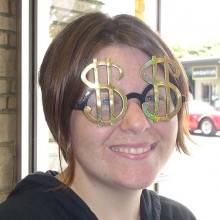 There are two things that most of us have in common when it comes to money. First, that we like it, at least in a general sense. Second, we don’t have any of it. The recession – which the government insists has been over for some time – has hit most Americans like a bag of oranges to the face. There is less to go around while prices skyrocket on everything from gas to groceries. It is enough to make anyone feel like they are getting screwed by the monetary system.
There are two things that most of us have in common when it comes to money. First, that we like it, at least in a general sense. Second, we don’t have any of it. The recession – which the government insists has been over for some time – has hit most Americans like a bag of oranges to the face. There is less to go around while prices skyrocket on everything from gas to groceries. It is enough to make anyone feel like they are getting screwed by the monetary system.
But you shouldn’t blame money itself. After all, the economy isn’t real. It is all metaphorical and imaginary, with fake dollars being projected and logged in computers, which are then regurgitated back at us like a never ending loop of doom. It has hardly anything to do with actual cash at all, much less how much exists.
Money itself is a great source for interesting (if useless) trivia and history. Of course, this is coming from a huge geek who has collected coins and foreign currency from the time they were a small child. Which might just make me one of the dullest people on the planet. If you are in the same category, or if you have just stuck with me this far, check out these ten fascinating facts about moolah.
- The first colony to print and issue paper money instead of coins was Massachusetts Bay in 1690.
- Until 1877, multiple agencies could print currency which was then distributed around the country. But that year, the Bureau of Engraving and Printing, a part of the Treasury, took full responsibility. It was in 1894 that they also began to print postage stamps.
- While the Mint is usually thought of primarily as a place where money is printed or notes distributed, they also do military and Congressional medals. Any time you see a soldier with a medal denoting his rank or achievements you are seeing something made by the Mint.
- Were you aware that the Treasury has their own Secret Service? They aren’t the guys who stand around in ear pieces and sunglasses, but they are still important. In 1865, the branch was created to detect and stop counterfeiting. Then, a few years later, they were told to also stop fraud against the government. That was their only duty until 1894, when they were also used to protect the president, starting with Grover Cleveland.
- It is called “legal tender” because it was originally seen as a means of paying of debts, public charges and taxes. The amounts were usually higher than could be covered easily with coins, so paper money was more convenient.
- In most other countries, currency is made in various colors in order to help differentiate between the amounts. But there is a reason the U.S only uses the color green; in fact, there are three. First, it is because the color is very hard to chemically change. Second, the ink used was available at the time in large enough quantities to handle the printing. Third, the color has a psychological effect, making people think of strong credit and monetary amount, making them more eager to spend. This stimulates the economy.
- For three years during WWII, from 1942 to 1945, pennies looked silvery and different. This is because copper was a highly valuable resource that was needed for the war effort, and so they were made of steel coated in zinc. Nickels also had no actual nickel in them, but were made from small traces of copper, magnesium and silver. Even today, copper is mixed with other materials to make coins, such as copper/nickel mixes.
- While this three years period was the exception, nickels are the only coins to stay the same since their creation in 1866. All others have seen major changes over the years.
- For all the debate about “In God We Trust” being on money, it was not always there. In fact, it wasn’t until 1955 that is was widely used, being only on a few coins starting from the time of the Civil War.
- It is tradition for the people placed on coins to be long dead. But in 1926, Calvin Coolidge became the first President to have a coin before he passed. I can only assume it was because he had such an awesome name.
See? Currency history isn’t all boring…there is a lot the average person doesn’t know! These are only a few of my own personal favorites,which might seem a little sad to those who have lives more exciting than someone who has every first edition of the new U.S quarters in a fold out, leather bound collector’s book.
DO you have any fun facts to share? Leave them in the comments.
About the author: Jessy Troy is a frugal mom, Internet geek and stay at home mom blogging for Mobile Phone Finder, the free Australian service allowing to quickly conpare mobile phone plans.
